History

…42nd Street was where tourists and locals alike went to mix with the moving crowd, to feel New York’s erratic, racing pulse. No place in the city was as vividly present tense as 42nd Street and yet so redolent of nostalgic associations, especially for the native New Yorker. Each of the street’s successive incarnations was deeply imprinted on the public consciousness and lived on in the city’s collective memory — in the 42nd Street of the mind — long after its day had passed.
- Anthony Bianco
The history of Times Square, formerly Long Acre Square, began in 1904 when it was renamed after the famous newspaper The New York Times. Times editor, Adolph S. Ochs, decided to build a new headquarters for the paper in the heart of the city. Later that year the area earned the nickname “Crossroads of the World” when a subway station was built directly beneath 42nd Street and Broadway.  By 1915 the station was the city’s central point of connection for public transport, linking subways that traveled to all points of Manhattan, thus making Times Square the most accessible part of New York City.
By 1915 the station was the city’s central point of connection for public transport, linking subways that traveled to all points of Manhattan, thus making Times Square the most accessible part of New York City.
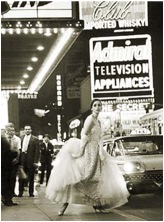 Because of all the traffic generated by this transport system, Times Square became a pivotal point of commercial advertisement and public entertainment. Numerous theatres were erected in the area giving it the nickname “the Rialto” or “The Theatre District.” Hundreds of high-end elitists flocked to the theatres in search of quality entertainment. By the 1920s, Times Square was known as “The Great White Way” where life is sweet “on the street that never sleeps.”
Because of all the traffic generated by this transport system, Times Square became a pivotal point of commercial advertisement and public entertainment. Numerous theatres were erected in the area giving it the nickname “the Rialto” or “The Theatre District.” Hundreds of high-end elitists flocked to the theatres in search of quality entertainment. By the 1920s, Times Square was known as “The Great White Way” where life is sweet “on the street that never sleeps.”
However, at the turn of the decade, economic backlash from the Great Depression led to a shift in the definition of entertainment. Instead of Broadway shows and theatre, the motion picture became the most popular form of entertainment, because it occupied a medium between the expensive, luxurious theatre shows and dirty cheap nickelodeons. This change in public amusement took form as the theatres of the “Great White Way” were converted into movie houses that specialized in “Grinders,”  reruns of old movies emphasizing violence, action and female sexuality, which appealed to male rather than family audiences. Times Square, once known as a destination for clean entertainment became identified as a place of dirty pleasures. As the changes intensified, the area drew diverse crowds, including many homeless. As a result, people began to perceive 42nd Street as frightening and dangerous, and that misconception came to define the area for decades to come.
reruns of old movies emphasizing violence, action and female sexuality, which appealed to male rather than family audiences. Times Square, once known as a destination for clean entertainment became identified as a place of dirty pleasures. As the changes intensified, the area drew diverse crowds, including many homeless. As a result, people began to perceive 42nd Street as frightening and dangerous, and that misconception came to define the area for decades to come.
As the years past, the once beautiful Times Square continued to descend in an on-going spiral of urban decay. To counteract this upsetting trend, Fiorella Laguardia, Mayor of New York City from 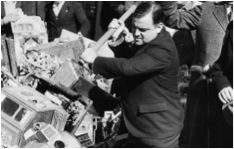 1934 to 1945, began a personal rebellion against the city’s newest form of entertainment. Through a number of legal actions, the government attempted to rid 42nd street of Burlesque Theatres. Unfortunately, his efforts were not enough and Times Square offered around the clock entertainment through movie theatres, adult bookstores, and arcades.
1934 to 1945, began a personal rebellion against the city’s newest form of entertainment. Through a number of legal actions, the government attempted to rid 42nd street of Burlesque Theatres. Unfortunately, his efforts were not enough and Times Square offered around the clock entertainment through movie theatres, adult bookstores, and arcades.
Known as “Broadway’s Mayor,” John Lindsay, adopted the cause of theatre restoration as a way to improve the overall aesthetic of New York He created the Midtown Economic Development, an agency that provided property owners to build and expand. Though a few small theatres were built, they were insignificant and ultimately ineffectual.
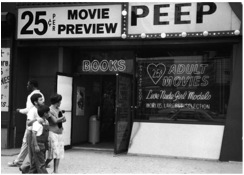 Around this time, Marty Hodas invented the x-rated peep show and consequentially, pornography became a widespread market in Times Square. The explosion of the sex market on 42nd street resulted in a downward plunge in the real estate value. Landowners were willing to accept any tenants available and that, along with the growth of a booming sex industry in the area, caused a major decline in the quality of life in Times Square.
Around this time, Marty Hodas invented the x-rated peep show and consequentially, pornography became a widespread market in Times Square. The explosion of the sex market on 42nd street resulted in a downward plunge in the real estate value. Landowners were willing to accept any tenants available and that, along with the growth of a booming sex industry in the area, caused a major decline in the quality of life in Times Square.
After a series of insignificant changes during Abraham Beame’s administration, Mayor Ed Koch took the first step to restoring the area to it past glory. His main tactic in restoring Times Square was in employing the policies of eminent domain, which allowed the city to take control of buildings that were in ruins, violated zoning regions or were found to be illegal in any other manner.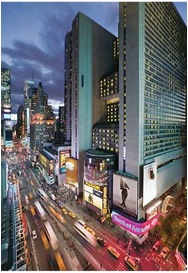 Once seized, the city had the power to dispose of the building, or in the case of Times Square, redevelop it as seen fit by the government. Koch used this power to destroy numerous crumbling theaters and make room for the new Marriott Marquise Hotel that he hoped would invite a different clientele to the area. Koch was also helpful in trying to diminish the number of homeless people, mostly teenagers, roaming the streets near Times Square, thereby improving the quality of its inhabitants.
Once seized, the city had the power to dispose of the building, or in the case of Times Square, redevelop it as seen fit by the government. Koch used this power to destroy numerous crumbling theaters and make room for the new Marriott Marquise Hotel that he hoped would invite a different clientele to the area. Koch was also helpful in trying to diminish the number of homeless people, mostly teenagers, roaming the streets near Times Square, thereby improving the quality of its inhabitants.
Though Koch’s main focus was reestablishing the economic stability of New York City, he did take much aggressive action to remove and restore as many old buildings as possible. His main agenda was to transform Times Square into a major commercial district. He created the first 42nd Street Development Project, whose main purpose was to develop office towers, making Times Square the center of commerce rather than the heart of urban entertainment. Many criticized Koch for attempting to rob Times Square of its symbolic significance as entertainment district of New York.
His main agenda was to transform Times Square into a major commercial district. He created the first 42nd Street Development Project, whose main purpose was to develop office towers, making Times Square the center of commerce rather than the heart of urban entertainment. Many criticized Koch for attempting to rob Times Square of its symbolic significance as entertainment district of New York.
David Dinkins took office in 1990, and though he distanced himself from the Times Square problem, it was during his administration that the major reformations began. Rebecca Robertson, a member of the City Planning Commission during the time, worked tirelessly to redirect the emphasis of the 42DP from corporate development back to theater restoration and preservation. 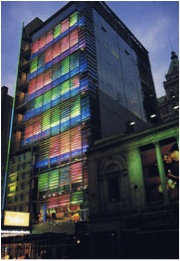 Robertson created a new Board of Directors, consisting of individuals with great social power and influence. She named her project the “New 42nd Street,” representing the new direction and initiative she was taking with the famous (and infamous) Times Square. In 1992, her team formed the BID (Business Improvement District) of Times Square to “provide a mechanism by which property owners in Times Square could pool their resources to make the ‘Crossroads of the World’ clean, safe, and friendly.” The BID hired a private sanitation crew and 40 public safety officers, opened visitor center for tourists, created homeless outreach teams, and began “Broadway on Broadway,” a show consisting of songs from musicals, in an effort to advertise and increase ticket sales. By end of the year, the sex and drug industries began to decrease and for first time in 47 years, the number of murders on 42nd street decreased as well.
Robertson created a new Board of Directors, consisting of individuals with great social power and influence. She named her project the “New 42nd Street,” representing the new direction and initiative she was taking with the famous (and infamous) Times Square. In 1992, her team formed the BID (Business Improvement District) of Times Square to “provide a mechanism by which property owners in Times Square could pool their resources to make the ‘Crossroads of the World’ clean, safe, and friendly.” The BID hired a private sanitation crew and 40 public safety officers, opened visitor center for tourists, created homeless outreach teams, and began “Broadway on Broadway,” a show consisting of songs from musicals, in an effort to advertise and increase ticket sales. By end of the year, the sex and drug industries began to decrease and for first time in 47 years, the number of murders on 42nd street decreased as well.
As Robertson was organizing her new board, Marion Heiskell, member of the New 42DP, found herself seated next to Michael Eisner, CEO of Disney Corporation, on a flight to LA. She showed him a map of Times Square, pointing out the place where she thought Disney theater should be located. At first, Eisner opposed the idea of a Disney establishment on the most porn laden street in New York. A move like that would risk Disney’s reputation as a family friendly corporation. However, after some convincing from Robert Stern, an architect hired by Rebecca Robertson, who also happened to be on Disney’s Executive Board, Eisner agreed to restore the New Amsterdam Theater.
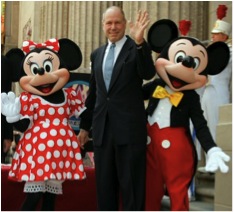 On December 31st, 1993, the day that Rudolph W. Giuliani became Mayor o NYC, Eisner finally signed a heavily conditional letter of intent to take over the theater. Giuliani reassured a hesitant Eisner that he was fully committed to signing the deal, and that cleaning up the street would be a priority.
On December 31st, 1993, the day that Rudolph W. Giuliani became Mayor o NYC, Eisner finally signed a heavily conditional letter of intent to take over the theater. Giuliani reassured a hesitant Eisner that he was fully committed to signing the deal, and that cleaning up the street would be a priority.
The Disney deal opened the doors for numerous entertainment firms and business corporations to move into Times Square, seeking a stake in the now profitable area. MTV Studios, Madame Tussaud’s Wax Museum, AMC Theatres, and ESPN Zone all flooded to the area, bringing a family friendly presence to Times Square. After half a decade, Times Square has been restored to its original glory, albeit in a different form. It has become a hub of entertainment, business, and tourism; “the street that never sleeps,” at the center of the city that never sleeps.

To see what Times Square looks like in modern times, check out Times Square Today.